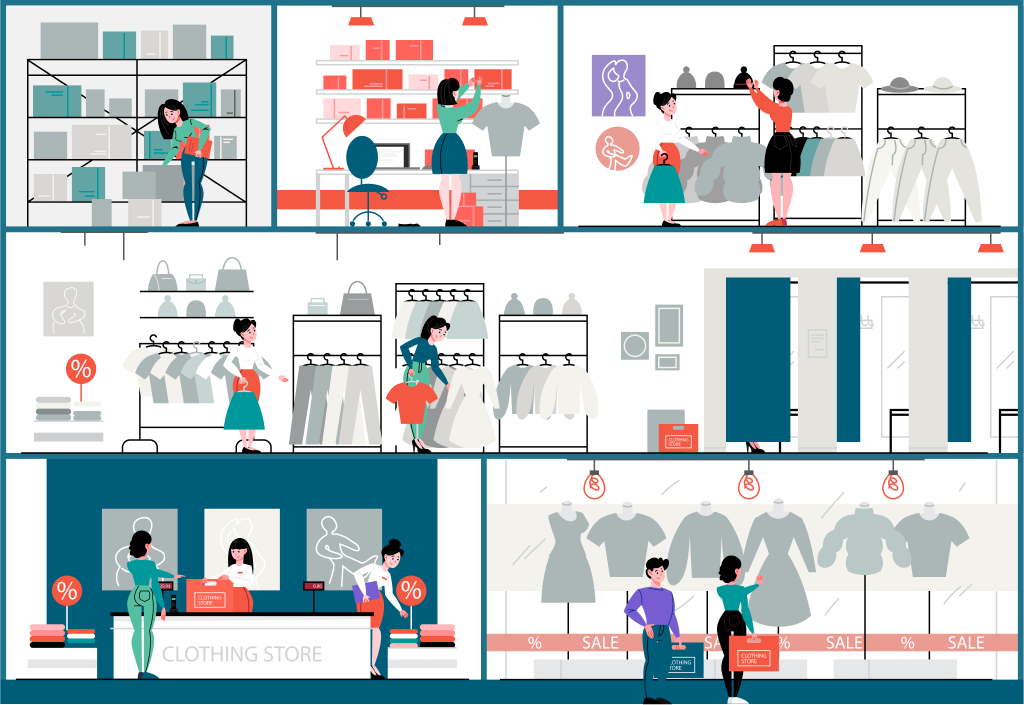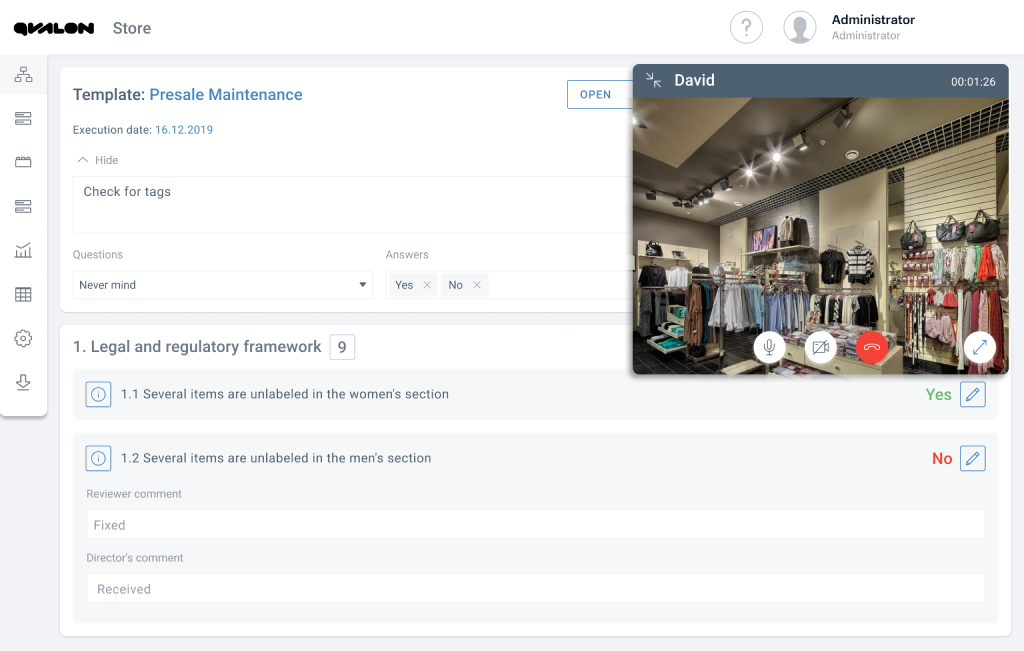Qvalon Blog article content
The Fashion Industry is a special sphere of business to begin with, and unlike food for example, clothing is not an everyday purchase. The process of buying clothes for most of us is not just a trip to the store, but a whole ceremony for which we are ready to spend a lot of time, energy, and, of course, emotion. It is the emotional component that distinguishes fashion shopping from any other. It is also this emotional component that influences the peculiarities of the operational processes of fashion retail.

The task of any fashion retailer is to create an unforgettable aesthetic atmosphere for the customer, design a comfortable shopping experience, and provide high-class service and services. This is no small task, and it creates a complex and competitive struggle to attract and retain customers. The companies who win, will be the companies whose internal operating processes effectively drive the quality and execution of the service that the customer receives.
Each fashion company has different operational processes that indirectly or directly affect financial performance and customer service, but in all of them there are the 6 basic units of processes that impact work at the store level:
- warehouse operating processes;
- operational processes on the sales floor;
- merchandising of the sales area-one of the biggest processes of the sales area;
- operating processes in the dressing room area;
- cash operating processes;
- display.
The quality of execution for these processes impacts how many customers make it to check out and purchase, so the implementation of successful processes in these areas creates success for the business.
Let’s take a closer look and see how we can evaluate the efficacy of current processes:
- Are all processes that provide competitive service implemented and formalized in your network?
- To what extent are the existing processes and procedures relevant?
- Which of the processes require modernization and which should be cut?
- How well are the processes performed by your staff?
- How effective are your employees in meeting the company’s standards and operational processes?
Beyond these questions, there are a lot of similar questions that can be asked and the answers to those questions will lead you to logical, actionable conclusions. The questions is, where can you find a tool that will help you get answers to all of these questions, and see the real picture of your business?
Among a variety of modern IT technologies, the Qvalon system is a service that has proven itself in various areas of business, including the fashion industry. With the help of Qvalon, you can implement a wide range of business tasks in fashion retail:
- Automate the inspection process of your operating stores network with the digitization of electronic checklists, photo reports, surveys, and the generation of informative reports. Get data on the operational efficiency of network personnel.
- The platform allows you to solve problems related to HR: management of staff hours, on-boarding new employees, training, corporate standards, regulations, control of knowledge, the creation of reserve personnel.
- Qvalon helps to build and control the channels of communication between the company and their partners, and counterparties (Case Modis with Security).
- The Qvalon service is a good assistant in monitoring compliance with government agencies and regulations, identifying and preventing violations within the framework of trade regulations, fire supervision, labor protection, as well as compliance with sanitary and epidemiological standards.
- Qvalon helps you to understand and analyze the competitive environment, as well as determining your position in the competitive landscape. It calculates the customer loyalty index, and provides accurate feedback from customers on your company’s products and services.
What makes the Qvalon system unique is that with the help of a set of its functional modules, you can develop and implement custom scenarios, as well as individual cases for the specific tasks of each customer.
Let’s analyze step by step, specifically for fashion retail, what operational processes within each unit can be monitored, digitized, and analyzed using the platform, and what effective forms of audit can be implemented for these processes.

Warehouse operating processes
Using the modules of the Qvalon system, checklists, photo reports, polls can be checked for:
1. The Warehouse planogram
A warehouse is not just a room for storing goods, but a functionally organized space to facilitate the movement of goods between a warehouse and a sales unit. The quality of the execution of operational processes in the sales unit will depend on the quality of the organization of the warehouse space, its ergonomics. The principle of organizing the warehouse space is found in the “Warehouse planogram”.
The steps and processes that produced the goods in the warehouse are hidden from the buyer’s eyes, but this does not mean that these operations should have more lenient standards than for the transactions made on the sales floor.
2. Acceptance of goods/reinventorying of goods/posting of goods into the accounting system
For the reception, conversion, and posting of goods it‘s usually necessary to apply formulas that save time and errors, avoid shortages and surpluses, and allow time to fix and align the re-sorting of inventory balances.
3. Defects: cancellation of the defects/storage of defects
Defects can be found not only during the acceptance of goods-sellers often find defective goods on the sales floor, and customers don’t want defective goods for obvious reasons. All of these incidents must be documented, and certain adjustments need to be made to the defective goods according to the company’s standards.
4. “Conservation” of goods
Often in fashion companies there may be a need for the seasonal storage of goods in a store’s warehouse without transporting it to the company’s main warehouse — the process of “conservation”. The organization of the “conservation” process requires personnel to strictly follow certain formulas to minimize errors in the accounting of goods.
5. Presale Maintenance/QC Items: steaming goods/price tags / anti-theft sensors
The execution and quality of execution of this set of measures is crucial, since it creates the image of the product in the eyes of the customer (the product is ironed, attractive, and the price is displayed), which increases the chances of purchase, and helps the seller prevent possible material losses.
Sales floor operating processes
As noted earlier, the operational processes of the sales area are inextricably linked with the operational processes of the warehouse, and poor quality/execution of warehouse operations in one way or another affects the quality of operations in the sales area.
What we can control with Qvalon on the sales floor:
1. Sorting at the sales area from the warehouse
Choice in product display is crucial-customer’s want what they want, when they want it, and sellers are obligated to provide it. To provide the customer with choice, the seller has to maintain a full range of available products, in all available colors and sizes, in the sales area. This means that staff need to constantly be sorting goods, and the process of sorting goods is not a one-time process-it occurs cyclically after customers buy out size ranges and models. Employees need to control this process, and quickly refresh the assortment of products in the the sales area. This process needs to be organized so that any employee regardless of his/her experience in the industry or at the company, can quickly find the product they need and display it in the sales area or present it directly to the customer.
2. Goods revaluation
Revaluation of goods is an equally important process that must be legally controlled by each seller since the price on the product label always has to correspond to the price of the goods in the accounting system. Customer loyalty to the company depends on consistent revaluation because even one case of discrepancy between the price indicated on the product and the price charged by the cashier at checkout, can leave a negative impression on the customer and damage trust between the customer and the brand in the long term. Beyond that, inaccurate pricing can lead to fines and penalties from government agencies.
3. Merchandising
Merchandising is a complex, voluminous operational process that includes several sub-processes:
- the process of placing groups of goods on the sales floor-zoning;
- the process of presenting goods: display/signage of goods on various types of trade equipment-planogram;
- the process of registering Promo goods with materials.
In the fashion industry, the implementation and maintenance of merchandising standards at a high level is not easy, and is accompanied by additional layers of complexity — a constant change of goods and displays related to seasonality, the introduction of new collections, sales seasons, promo activities, and the sales of hit models.
Beyond that, store sales also dictate which products/displays can and should be comfortably presented to the buyer.
The most effective module of the Qvalon system for checking merchandising standards is the Photo Reports module, which has been successfully used by merchandising specialists from various fashion companies. The module contains a whole set of functional options to make standards control process , transparent to both Merchandisers, as well as Director of Sales and up.
4. Buyer services: consulting/services/speech scripts/standards of staff appearance
It’s no secret that regardless of the company’s business model, pricing policy, store format, or product characteristics, high-quality customer service is the main component of success in the fashion industry, especially at the store level. If store personnel don’t provide customers with the highest level of attention, courtesy, and care, the store will lose sales. The challenge is that all customers are different, but sellers need to provide the same quality of service to every customer. To prevent negative interactions between sellers and customers and increase the likelihood of sales, companies often develop formulas for employee actions, speech scripts, etc. Unfortunately, the presence of scripts and formulas does not yet guarantee that the staff performs them correctly. With the help of different modules of the Qvalon system such as checklists, photo reports, and video analytics, managers can get real-time information about how well service standards are upheld both at the store, and in the entire network. If your company has also implemented standards for the appearance of personnel, then using the above modules you can also track the adherence to those standards and protocols.
5. Atmosphere and cleanliness of sales area: the style and volume of the music content, video content, advertising, and information content/lighting/temperature/smells/order
As we mentioned earlier, an important component of fashion shopping is emotion-and the emotion that a buyer experiences when visiting your store depends on you, and your store’s preparedness. Retailers themselves shape the emotional experience of the customer by creating a clean, comfortable, engaging atmosphere at the point of sale.
Operational processes, standards in the fitting room area
The fitting room area is the part of the store where the customer makes the final decision on the purchase , as well as the number of items that they will buy. Sellers should not miss the chance to complete a transaction and increase the average check because their dressing room isn’t in order. For the purchase to take place, the store needs to implement and monitor all processes and work standards in the dressing room area-more specifically:
- Customer service: the presence of a trained store employee in the dressing room area to direct customers to their fitting room and help them select the right size, product model, advise on product quality, composition, style, and upsells/cross-sells.
- Control and monitor the preservation of goods: giving customers a marker with the number of items that were taken into the fitting room and ensuring that all items have an anti-theft sensor.
- Order in the fitting room area, and functionality of the fitting room equipment: rug, mirror, shoehorn, etc.
- Organization of the material and goods in the fitting room area: hanging items on hangers, stacking items neatly in piles, taking goods out of the dressing room area, and hanging items in the sales area.
Cashier operating processes
Cash Area — this is a strategically important area, a high touch point between the customer and the brand, and that means that everything needs to transact smoothly. All processes and customer experience when transacting should leave the customer with a feeling of trust and care, as this creates a lasting impression and engenders customer loyalty.
Qvalon’s system helps implement, maintain and measure the Cashier Operating standards:
- Order must be maintained in the checkout area.
- Correctly displaying impulse purchase goods in the checkout area.
- The checkout area should always be equipped with sufficient work inventory: receipt tape, packages, discount cards, questionnaires for discount cards, questionnaires for applicants, change, etc.
- Cash records must be filled out regularly, without errors, according to standards.
- Cash transactions should also be carried out according to standards: transacting with the buyer, registration of returns, withdrawal reports, making deposits, withdrawals from the cash register, and so on.
- All cashiers using unified scripts and sets of actions related to the buyer when communicating.
Display (shopwindow)
Once again returning to the emotional component of fashion shopping, it should be noted that the first impressions about the store, the desire to enter, get acquainted with the products and services, are formed by the customer when the see the display windows. The showcase is the face of the store and this face should distinguish your store from competitors, both with decorative design and tastefully selected images. At the same time, you can’t lose sight of the basic standards of window dressing that exist in each company.
Using Qvalon, we check and fix:
- The cleanliness of shop windows, the space behind the shop window, podiums, mannequins.
- Lighting of displays, mannequins, showcase posters.
- Grouping of mannequins according to the standards and types of displays.
- Product presentation standards on mannequins.
- Availability of up-to-date display posters.
Now it’s time to talk about the forms of operational audit in fashion retail
The most widespread and popular form of audit is a check of the store by a senior manager, usually a supervisor, a cluster or regional director.

The verification formula is simple and straightforward:
- The manager plans in advance a schedule of checks of his/her stores in the calendar of the Qvalon system. On the selected date he/she checks using an electronic checklist, fixes deviations from standards, forms a list of tasks to address, and sends the results of the check including a list of tasks to all of the relevant company contacts (including the responsible employees). After that, the manager can monitor the status and quality of task execution, and conduct a final analysis using the Qvalon analytical module.
- The second popular form is the use of third-party auditors, “mystery shoppers”, to assess the how well standards are being implemented. The verification formula is almost identical to the previous one, only in this case there can be one additional stage — analyzing and coordinating the results of the verification, which is usually done by a specialist from the company. In practice, the same cluster of directors, territorial directors, and managers are authorized to change the final report.
- The third, and least common, but effective form of observing the performance, quality, and execution of operational processes, are “self-tests” of a store by the store director/manager. This form of audit has plenty of positives:
- Store director/manager gets a list of standards, processes, and requirements and can evaluate them through multiple loops of self-tests. This prevents him/her from missing anything important in the work.
- When standards change or new standards are implemented, the director/manager will be aware of the updates, since all of the changes are immediately reflected in the electronic self-test checklist template.
- If the director/manager is new, then this form of observation will help to quickly get acquainted with the company’s standards and go through the adaptation process.
- The self-checks by director/manager will help to identify in advance errors that could be recorded by managers or representatives of city/state authorities, and to prevent consequences such as fines, or the suspension of licenses.
- The self-checks by the director/manager allows the store to be at their best when they meet customers, and to create a comfortable shopping atmosphere.



